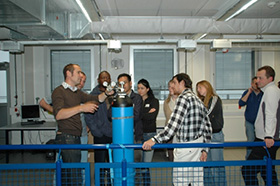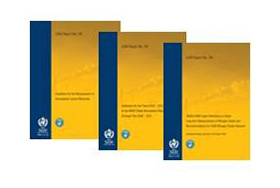Quality Assurance/Scientific Activity Centre (QA/SAC Switzerland)
The GAW Quality Assurance/Scientific Activity Centre (QA/SAC Switzerland), funded by MeteoSwiss and Empa, was established in 2000. Being closely linked to the World Calibration Centre also hosted by Empa, the QA/SAC mainly focuses on surface ozone, carbon monoxide, methane and carbon dioxide measurements but is also broader in scope and provides technical and scientific support in general.
The main tasks of QA/SAC Switzerland are
- science activities fostering steady analytical progress,
- training, twinning, and capacity building, e.g. through GAWTEC,
- contribution to GAW outreach,
- networking / cooperation with other programmes / projects in line with the GAW strategy
- previous QA/SAC activities also focussed on the development and operation of the GAW Station Information System (GAWSIS); this task was later on transferred to MeteoSwiss.
Science activities
The latter includes
- evaluation of novel measurement techniques and their performance improvement
- assessment of their applicability for long-term monitoring purposes, e.g. through long-term side-by-side intercomparisons
- dissemination of know-how to the GAW community through publications and presentations at conferences
A highlight was the organisation of the 19th WMO/IAEA Meeting on Carbon Dioxide, Other Greenhouse Gases, and Related Measurement Techniques (GGMT-2017) in August 2017 at Empa (see GGMT-2017 conference web page).
Training, twinning, and capacity building
Twinning is one of the core activities of QA/SAC Switzerland since the early beginning. The main twinning stations are Assekrem (Algeria), Bukit Koto Tabang (Indonesia) and Mt. Kenya (Kenya). These stations were established in the mid-1990ies under the WMO/UNDP/GEF programme. It was recognized that a continuous support is key to maintaining high-precision observations in line with the GAW requirements after the end of the initial programme. From summer 2022 to summer 2025, QA/SAC Switzerland's activities will be intensified in Kenya due to our involvement in the European Commission's KADI (Knowledge and climate services from an African observation and Data research Infrastructure) project. Within KADI, we are mainly engaged in compiling criteria and requirements critical for a successful and sustainable operation of atmospheric and ecosystem observations in East Africa and in reporting variability, trends and seasonalities of atmospheric observations.
QA/SAC also supports many other stations. In general, successful twinning has many aspects, such as
- advice for instrument selection and operation
- technical support / advice to set up measurement capabilities
- regular on-site training (along with WCC-Empa)
- remote support / trouble shooting
- facilitating the provision of spare parts
- support for quality control, data processing and data submission
- support for (research) proposal writing
- support for scientific data analysis and publication
In addition, QA/SAC Switzerland tries to reach out to a wider audience of station operators and other GAW-related staff through various training and teaching activities. In recent years, training courses and lectures (both on-site as well as through teleconferencing) were given e.g. in Argentina, Bolivia, Indonesia, Japan or Puerto Rico.
QA/SAC Switzerland has been also a partner of the GAW Training and Education Center (GAWTEC) for a long time. GAWTEC, a German contribution to GAW, provides technical guidance through twice yearly training courses, where QA/SAC Switzerland is regularly involved in teaching.
GAW outreach
Contributions to GAW reports were e.g. made to GAW Report No. 192 (Guidelines for the Measurement of Atmospheric Carbon Monoxide), GAW Report No. 195 (WMO/GAW Expert Workshop on Global Long-term Measurements of Nitrogen Oxides and Recommendations for GAW Nitrogen Oxides Network), GAW Report No. 209 (Guidelines for Continuous Measurements of Ozone in the Troposphere), and by being editor of the two most recent GAW reports of the WMO/IAEA Meetings on Carbon Dioxide, Other Greenhouse Gases and Related Tracers Measurement Techniques (GGMT) (GAW Reports No. 242 and 255).
Networking
QA/SAC Switzerland supports and cooperates with various activities in line with the GAW strategy of particular projects such as ICOS (Integrated Carbon Observation System), ACTRIS (Aerosols, Clouds and Trace gases Research InfraStructure network), the Integrated Global Greenhouse Gas Information System (IG3IS), the Tropospheric Ozone Assessment Report (TOAR) activity, and the Virtual Alpine Observatory (VAO). It is recognized by the global GAW community that regional programmes and projects do pioneer work by addressing open issues such as network homogenization, uncertainty estimation, and improvement and consolidation of networks. However, it is also concluded that those activities have to be thoroughly accompanied to ensure a tight linkage to the GAW programme
New activity: early detection of data quality issues
QA/SAC-CH successfully engages in training and support for the operation and maintenance of the on-site instrumentation for many years. However, the timely and autonomous detection of instrument malfunctioning at the station level is often not sufficiently reliable and frequently leads to long delays before the necessary interventions.
Quality-assurance is mainly a local responsibility, and relevant information about maintenance, pollution events etc. is often only available to the local operator. Thus, data processing should remain largely in their hands but additional support may significantly speed-up interventions, and, consequently, increase the data availability.
To do so, we currently develop a novel, data-driven approach for a timely data review and the identification of suspicious measurements. The corresponding tool will be applied to the quality-controlled data by the station operators. This introduces an intermediate process prior to the submission of the data to the world data centres. A simple online graphical user interface will encourage stations operators to apply this process regularly and in a timely fashion, i.e. much more frequently than the common yearly intervals of submission to the data centres.
We apply data science approaches to the existing long-term time-series available at the world data centres, as well as to the newly processed data. Supervised (e.g. random forest regression, generalized additive models) and unsupervised (cluster analysis) learning approaches will be explored to identify suspicious recent measurements based on the past (training) data.
The dashboard is accessible at this link. We are currently looking for station operators that are willing to try out the application and provide feedback and/or report bugs. To inspect recent measurements, a data file with hourly average must be prepared beforehand. However, you can immediately play around with historical data that are already at the GAW data centres. More information can be found on this link. A tutorial on how to inspect recent measurements is available here.
QA/SACs worldwide
QA/SAC Switzerland is one of five established QA/SACs in WMO's GAW programme. Other QA/SACs are established in Germany (at German Environment Agency and Research Centre Jülich), the Unites States and Japan.

Global Atmosphere Watch: Introduction
WCC-Empa (World Calibration Centre for Surface Ozone, Carbon Monoxide, Methane and Carbon Dioxide)
QA/SAC Switzerland (Quality Assurance/Scientific Activity Centre)
GAW-qc (Interactive quality control tool for atmospheric composition measurements)
GAWSIS (GAW Station Information System)
GAW Report No. 255 (2024): 21st WMO/IAEA Meeting on Carbon Dioxide, Other Greenhouse Gases and Related Measurement Techniques (GGMT-2022)
GAW Report No. 209 (2013): Guidelines for Continuous Measurements of Ozone in the Troposphere
GAW Report No. 195 (2011): WMO/GAW Expert Workshop on Global Long-term Measurements of Nitrogen Oxides and Recommendations for GAW Nitrogen Oxides Network
GAW Report No. 192 (2010): Guidelines for the Measurement of Atmospheric Carbon Monoxide
material from selected presentations can be found here
-
Share


